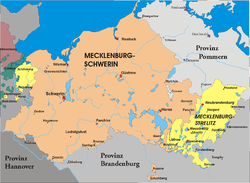
Back دوقية مكلنبورغ شفيرين الكبرى Arabic Мекленбург-Шверин Bulgarian Mecklenburg-Schwerin Breton Gran Ducat de Mecklenburg-Schwerin Catalan Mecklenburg-Schwerin Danish Mecklenburg-Schwerin German Μεγάλο Δουκάτο του Μέκλενμπουργκ-Σβερίν Greek Meklenburgo-Schwerin Esperanto Gran Ducado de Mecklemburgo-Schwerin Spanish Mecklenburg-Schwerini suurhertsogkond Estonian
Grand Duchy of Mecklenburg-Schwerin Großherzogtum Mecklenburg-Schwerin (German) | |||||||||
|---|---|---|---|---|---|---|---|---|---|
| 1815–1918 | |||||||||
 The Grand Duchy of Mecklenburg-Schwerin within the German Empire | |||||||||
 Map of Mecklenburg-Schwerin (orange) | |||||||||
| Status |
| ||||||||
| Capital | Schwerin 53°38′0″N 11°25′0″E / 53.63333°N 11.41667°E | ||||||||
| Common languages | German, Low German | ||||||||
| Religion | Evangelical Lutheran State Church of Mecklenburg-Schwerin | ||||||||
| Government | Constitutional monarchy | ||||||||
| Grand Duke | |||||||||
• 1815–1837 | Frederick Francis I | ||||||||
• 1837–1842 | Paul Frederick | ||||||||
• 1842–1883 | Frederick Francis II | ||||||||
• 1883–1897 | Frederick Francis III | ||||||||
• 1897–1918 | Frederick Francis IV | ||||||||
| History | |||||||||
| 14 June 1815 | |||||||||
| 14 November 1918 | |||||||||
| Area | |||||||||
• Total | 13,161 km2 (5,081 sq mi) | ||||||||
| Currency | Mecklenburg thaler (to 1857) Vereinsthaler (to 1857–73) German gold mark (1873–1918) | ||||||||
| |||||||||
| Today part of | Germany | ||||||||

The Grand Duchy of Mecklenburg-Schwerin (German: Großherzogtum Mecklenburg-Schwerin) was a territory in Northern Germany held by the House of Mecklenburg residing at Schwerin. It was a sovereign member state of the German Confederation and became a federated state of the North German Confederation and finally of the German Empire in 1871.

